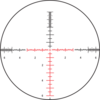D.B. Cooper
Member
- Joined
- Oct 2, 2016
- Messages
- 4,395
I'm looking to replace my rifle scope because the BDC isn't terribly useful. It's a Redfield and the manual says something to the effect of for all non magnum calibers 3-06 and below, zero at 200 yrds, use the dot for 300, and the post for 500. We all know how well that isn't going to work.
Excluding Zeiss and Swarovski, recommend a rifle scope that will let me have 200 yrd zeo, 300, 500 and maybe 600 yards holds that are all spot on. Pretty tall glass to fill.
Oh yeah. If it's relevant, rifle is an OLD Savage 110 in 243 Win. (Old as in flat black receiver, pre-accutrigger old.)
Excluding Zeiss and Swarovski, recommend a rifle scope that will let me have 200 yrd zeo, 300, 500 and maybe 600 yards holds that are all spot on. Pretty tall glass to fill.
Oh yeah. If it's relevant, rifle is an OLD Savage 110 in 243 Win. (Old as in flat black receiver, pre-accutrigger old.)




